Fish Eggs & Caviar
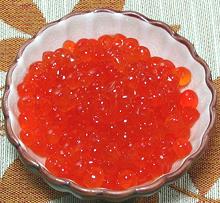
Fish eggs (roe) have been on the human menu for thousands of years,
prepared and eaten in various ways. According to the United Nations,
other international groups, and the U.S. Customs Service, the term
"Caviar" can only be used for the roe of Sturgeons and Paddlefish.
Despite this, in common usage, the eggs of other fish eggs that
have been salted and aged as sturgeon caviar is, are often also
called "caviar", clarified with the name of the fish the eggs came
from.
Because the difficulty of obtaining the eggs, the careful handling
required, and aging under tightly controlled conditions, any fish eggs
prepared in the caviar manner will be expensive, but demand for
sturgeon caviar by the ultra wealthy has taken the price to astronomical
heights. It's sort of like Sharkfin Soup for the Chinese - a way to
show off your absurd wealth at parties.
More on Fish Products
Sturgeon Caviar
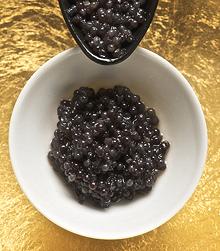 "Caviar' is properly the salted and aged roe of mature sturgeons, or
their close relative, the paddlefish. After being removed from the
fish, it is carefully graded, lightly salted and aged for two to
three months under tightly controlled conditions, then carefully
packed for shipment and sale. This processing has a definite effect
on the quality of the product.
"Caviar' is properly the salted and aged roe of mature sturgeons, or
their close relative, the paddlefish. After being removed from the
fish, it is carefully graded, lightly salted and aged for two to
three months under tightly controlled conditions, then carefully
packed for shipment and sale. This processing has a definite effect
on the quality of the product.
Originally, caviar was food for the poor. British soldiers in the
Crimean War complained there was nothing to eat but biscuits and
"salty fish jam", but caviar had already begun its ascent to glory
during the reign of Catherine the Great of Russia
Europe originally imported its caviar from the North American
Colonies, but severe over fishing ended that trade, and Europe turned
to Russia and Iran. The Atlantic Sturgeon is IUCN rated NT (Near
Threatened) and is extinct in parts of its range.
The largest caviar wholesaler, the French company of Petrossian,
has declared the age of wild harvested caviar essentially over -
victim of overfishing, pollution and habitat loss. From here on out it
will be from farmed fish. California sturgeon farms produce between
around 80% of all caviar harvested in North America, and it is
increasingly shipped worldwide. Petrossian has declared California
caviar to be be approaching the quality of the best Russian
products.
Photo of Beluga Caviar by Thor distributed under
license Creative Commons
Attribution 2.0 Generic.
Here are the traditional top Russian wild harvested caviars. Today,
wild is pretty much unavailable in the United States, but farmed
versions are becoming plentiful, at a price.
- Beluga: from Caspian Huso huso - the most
presigious caviar (see photo). It was selling for between 2016 US
$195 and $300 per ounce, but has been illegal to import into the
United States since 2005. The eggs are the largest of all sturgeon
eggs, and vary from nearly black to light gray, the lighter coming
from older fish and being the most desirable. It is served with
non-metallic mother of pearl caviar spoons to preserve flavor, and
is Usually served plain on toast or blinis, accompanied by Champaign.
CITES (Convention on International Trade in Endangered Species) has
banned all trade in Caspian Beluga, except some from Iran, because
Iran is judged to have the only effective fishing regulations. Various
Beluga hybrids are now farmed in several countries, and can be imported
into the US. Beluga/Siberian caviar sells in the range of 2019 US #170
to $250.
- Osetra: from Acipenser gueldenstaedtii -
the second most expensive grade. It is firmer than Beluga, and varies
from dark brown to golden, with the lighter versions considered best.
It is treated much as Beluga caviar is. This caviar originally came
from the Caspian Sea, but the leading producer now is fish farms in
Israel. Farmed Osetra sells in North America in the range of 2019 US
$64 to 160 / ounce.
- Sevruga: from Acipenser stellatus - the third
most expensive caviar and accounting for about half of traditional
caviar production because this fish matures faster than others. The
caviar is pearlescent gray and smaller than most sturgeon caviar. It
is farmed in Bulgaria, and possibly elsewhere, and sells for between
2016 US $75 and $150 / ounce, depending on grade and source.
Other Sturgeon Caviars are gaining market share due to scarcity and
high price of the three listed above.
- California: From Pacific White Sturgeon
(Acipenser transmontanus), this caviar has won praise from
the experts as difficult to tell from Russian Osetra. It sells for
between 2019 US $55 and $175 / ounce depending on grade.
California fish farms produce more than 80% of North American
caviar.
Other "Caviars"
Bowfin
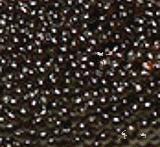 [Choupique (Cajun); Amia Calva]
[Choupique (Cajun); Amia Calva]
This is a popular low cost "caviar" with a unique flavor. Unlike sturgeon
caviar, it turns red if heated. Bowfin caviar sells on-line for around
2016 US $7.75 per ounce, plus overnight shipping.
Capelin
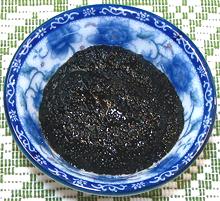 [Masago (sushi bars); Mallotus villosus]
[Masago (sushi bars); Mallotus villosus]
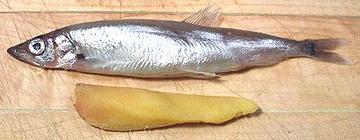 This circumpolar arctic smelt produces roe used in various ways. In
Japan the whole fish, laden with eggs, is lightly battered and fried.
The roe is also used fresh as sushi bars in Japan and California, as
masago. The Asian fish markets here in Los Angeles sell whole
egg filled Capelin when it is in season
This circumpolar arctic smelt produces roe used in various ways. In
Japan the whole fish, laden with eggs, is lightly battered and fried.
The roe is also used fresh as sushi bars in Japan and California, as
masago. The Asian fish markets here in Los Angeles sell whole
egg filled Capelin when it is in season
In sushi bars, the capelin eggs (masago) are usually dyed bright
red-orange.They are served on a dollop of sushi rice with a wrap of nori
seaweed around it to hold the eggs in place. For other markets they are
dyed black to resemble sturgeon caviar. The individual eggs are about
0.050 inch diameter (1.3 mm) The black specimen (pasteurized) was
purchased on-line at 2016 US $4.40 per ounce. For more on this fish
see Capelin.
Flying Fish
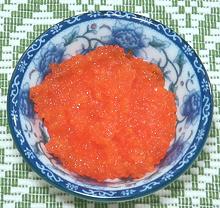 [Tobiko (Japan), family [Exocoetidae]
[Tobiko (Japan), family [Exocoetidae]
This fish roe is very popular in Japan for use as sushi topping and
garnishes for various small dishes. It is dyed orange, red, black, yellow
and green. Sometimes it is substituted with Masago (capelin roe) but
experienced sushi enthusiasts will notice the smaller size. Flying Fish
roe is about 0.08 inches (2.0 mm).
The photo specimen was purchased at a large Asian market in Los
Angeles (Alhambra), 3.6 ounces for 2019 US $7.99 ($2.22 / ounce). While
a product of Iceland, it was clearly made for the Japanese market,
including Japanese ingredients, and labeled "Tobiko". Ing: Flying fish
roe, salt, mirin, sugar, xanthan gum, citric acid, bonito extract,
soy sauce, rice vinegar, sodium sorbate, natural yellow #6.
Lumpfish
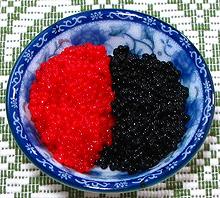 [Lumpsucker; Cyclopterus lumpus]
[Lumpsucker; Cyclopterus lumpus]
This is a popular low cost "caviar" from a very strange arctic and
subarctic fish. The individual eggs are about 0.085 inch diameter
(2.2 mm), firm, and stay very separate. They have a faint bitter
aftertaste, but not enough to be at all disturbing. The specimens
(pasteurized) were purchased on-line at 2016 US $2.29 per ounce
processed and packed in Iceland where lumpfish are common.
Paddlefish
 [Polyodon spathula]
[Polyodon spathula]
This fish is related to the sturgeon, and produces Caviar that is quite
similar, and is allowed by U.S. regulations to be labeled as Caviar. It
is a bit smaller than Sturgeon caviar, smoother in texture, and the eggs
have a bit less "pop". Color varies from steel gray to brownish gray.
Given the high price of sturgeon caviar, there is considerable interest
in farming this fish, both for meat and eggs, but also "ranching" them
(stocking reservoirs where they feed themselves). Paddlefish caviar
sells on-line for around 2016 US $24 per ounce, plus overnight shipping.
For more on this fish, see
Paddlefish.
Salmon
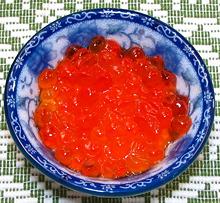 [Genus Oncorhynchus (Pacific) and Genus Salmo (Atlantic)
species]
[Genus Oncorhynchus (Pacific) and Genus Salmo (Atlantic)
species]
Compared to other "caviars", these eggs are very large, and are milder
and less salty. Flavor is good, the price is low (relatively), and these
eggs are quite popular. The individual eggs are about 0.25 inch diameter
(6.4 mm). The specimens were purchased bulk from the deli of a
multi-ethinic market in Los Angeles for 2016 US $2.19 per ounce.
Whitefish
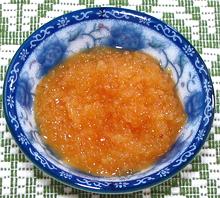 [Coregonus lavaretus (Europe) | Coregonus
clupeaformis (Probably actually the same species)]
[Coregonus lavaretus (Europe) | Coregonus
clupeaformis (Probably actually the same species)]
This is a relatively mild "caviar", similar in taste to Salmon "caviar",
which stands to reason since they are related fish, though the Whitefish
is smaller and produces much smaller eggs.The individual eggs are about
0.085 inch diameter (2.2 mm). The specimens (pasteurized) were purchased
on-line at 2016 US $5.10 per ounce - processed and packed in Iceland.
sf_eggsz 160921 - www.clovegarden.com
©Andrew Grygus - agryg@clovegarden.com - Photos
on this page not otherwise credited © cg1
- Linking to and non-commercial use of this page permitted
 This circumpolar arctic smelt produces roe used in various ways. In
Japan the whole fish, laden with eggs, is lightly battered and fried.
The roe is also used fresh as sushi bars in Japan and California, as
masago. The Asian fish markets here in Los Angeles sell whole
egg filled Capelin when it is in season
This circumpolar arctic smelt produces roe used in various ways. In
Japan the whole fish, laden with eggs, is lightly battered and fried.
The roe is also used fresh as sushi bars in Japan and California, as
masago. The Asian fish markets here in Los Angeles sell whole
egg filled Capelin when it is in season

 "Caviar' is properly the salted and aged roe of mature sturgeons, or
their close relative, the paddlefish. After being removed from the
fish, it is carefully graded, lightly salted and aged for two to
three months under tightly controlled conditions, then carefully
packed for shipment and sale. This processing has a definite effect
on the quality of the product.
"Caviar' is properly the salted and aged roe of mature sturgeons, or
their close relative, the paddlefish. After being removed from the
fish, it is carefully graded, lightly salted and aged for two to
three months under tightly controlled conditions, then carefully
packed for shipment and sale. This processing has a definite effect
on the quality of the product.
 [Choupique (Cajun); Amia Calva]
[Choupique (Cajun); Amia Calva]
 [Masago (sushi bars); Mallotus villosus]
[Masago (sushi bars); Mallotus villosus]
 [Tobiko (Japan), family [Exocoetidae]
[Tobiko (Japan), family [Exocoetidae]
 [Lumpsucker; Cyclopterus lumpus]
[Lumpsucker; Cyclopterus lumpus]
 [Polyodon spathula]
[Polyodon spathula]
 [Genus Oncorhynchus (Pacific) and Genus Salmo (Atlantic)
species]
[Genus Oncorhynchus (Pacific) and Genus Salmo (Atlantic)
species]
 [Coregonus lavaretus (Europe) | Coregonus
clupeaformis (Probably actually the same species)]
[Coregonus lavaretus (Europe) | Coregonus
clupeaformis (Probably actually the same species)]